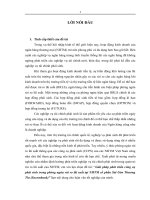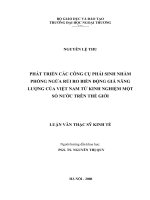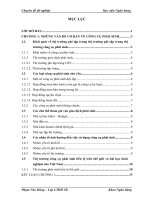Bài giảng chuyên đề Sử dụng các công cụ phái sinh vào phòng ngừa rủi ro tỷ giá - Bài 0 - Trường Đại Học Quốc Tế Hồng Bàng
Bạn đang xem bản rút gọn của tài liệu. Xem và tải ngay bản đầy đủ của tài liệu tại đây (338.72 KB, 7 trang )
<span class='text_page_counter'>(1)</span><div class='page_container' data-page=1>
<i><b>Int.J.Curr.Microbiol.App.Sci </b></i><b>(2017)</b><i><b> 6</b></i><b>(11): 3621-3632 </b>
3621
<b>Original Research Article </b>
<b>Optimization of Arginine Deaminase Production from Indigenous </b>
<b>Bacterium </b>
<i><b>Pseudomonas aeruginosa</b></i>
<b> PS2 </b>
<b>Anjana Sharma*, Kiran Bala and Islam Husain </b>
Bacteriology Laboratory, Department of P. G. Studies and Research in Biological Science,
Rani Durgavati University, Jabalpur, Madhya Pradesh, India
<i>*Corresponding author </i>
<i><b> </b></i> <i><b> </b></i><b>A B S T R A C T </b>
<i><b> </b></i>
<b>Introduction </b>
A molecule of biological origin has great
importance and plays a critical role in
sustaining of life on earth. Proteins and
peptides are the important class of
biomolecules possesses diversified
applications from the range of food and feed
to pharmaceutical industry. Today, proteins
and peptides based several pharmaceutics
such as interferons, blood factors,
thrombolytics, hormones, growth factors,
antibodies, and enzymes are used as
therapeutic agent for treatment of several life
threatening diseases viz. cancer, diabetes,
neurological disorder, coronary heart disease
and HIV/AIDS. L-arginine deaminase
(ADI) (E.C. 3.5.3.6) is an enzyme,
extensively investigated as enzymatic based
antineoplastic drug. As biocatalyst, ADI
catalyses the irreversible hydrolysis of
L-arginine to citrulline and ammonium (Wang
and Li, 2014) and widely used as therapeutic
agent for the treatment of
arginine-auxotrophic tumors, such as hepatocellular
carcinomas and melanomas (Yoon <i>et al.,</i>
2012; Changou <i>et al.,</i> 2014; Li <i>et al.,</i> 2016;
Sharma <i>et al.,</i> 2017). Mechanistically, the
anticancer effects of ADI is based on the fact
that arginine auxotrophic tumour cells more
specifically hepatocarcinomas, melanomas,
pancreatic carcinomas and few types of
<i>International Journal of Current Microbiology and Applied Sciences </i>
<i><b>ISSN: 2319-7706 Volume 6 Number 11 (2017) pp. 3621-3632 </b></i>
Journal homepage:
Arginine deaminase (ADI) is an important anticancer drug worldwide used in the
chemotherapy of arginine-auxotrophic tumors, such as hepatocellular carcinomas and
melanomas. To date, ADI obtained from <i>Mycoplasma</i> has been commercially used in
clinics. However, low yield, high toxicity, short proteolytic and low serum tolerances are
the major limitations of clinically available ADI. In the present investigation, we have
described optimization of environmental and nutritional requirements for maximum
biosynthesis of ADI from bacterium <i>Pseudomonas aeruginosa </i>PS2. We observed that
batch time 25 h, inoculum age 20 h, 8% (v/v) inoculum size, pH 6.5 and temperature 37 °C
were found as the most suitable operating conditions for ADI production. Galactose,
peptone, KH2PO4 and L-arginine were found as the best carbon, nitrogen, mineral ion and
inducer for ADI production, respectively. These results suggested that <i>P. aeruginosa </i>PS2
could be used for large-scale production of ADI but further studies are still required for
strengthening the current findings which are underway in our lab.
<b>K e y w o r d s </b>
Arginine deaminase,
Optimization,
<i>Pseudomonas </i>
<i>aeruginosa</i>, Cancer,
Fermentation
parameters.
<i><b>Accepted: </b></i>
26 September 2017
<i><b>Available Online:</b></i>
10 November 2017
</div>
<span class='text_page_counter'>(2)</span><div class='page_container' data-page=2>
<i><b>Int.J.Curr.Microbiol.App.Sci </b></i><b>(2017)</b><i><b> 6</b></i><b>(11): 3621-3632 </b>
3622
leukemia have shown lack expression of
argininosuccinate synthetase due to which
they are unable to synthesize their own
arginine. However, for rapid malignant
growth they require massive amount of
arginine. To fulfil their nutritional
requirement, they use arginine of circulating
system. The clinical administration of ADI,
hydrolyzes L-arginine of circulating system
into L-citrulline, and ammonia (Wang and Li,
2014) resulting in nutritional starvation which
leads selective apoptosis in cancer cells
(El-Sayed <i>et al.,</i> 2015). While, normal cells
remain unaffected or less affected due to
endogenous biosynthesis of arginine (Kim <i>et </i>
<i>al.,</i> 2009).
The Food and Drug Administration (FDA),
USA, and European Agency for the
Evaluation of Medicinal Products (EMEA)
have recognized PEG-ylated form of
<i>Mycoplasma</i> ADI (ADI-PEG-20) for the
treatment of hepatocellular carcinomas and
malignant melanomas.
Beside <i>Mycoplasma</i> ADI, many scientists
have reported ADI from various
microbiological sources viz. <i>Halobacterium </i>
<i>salinarium</i> (Monstadt <i>et al.,</i> 1990) <i>Giardia </i>
<i>lamblia</i> (Li <i>et al.,</i> 2009) <i>Porphyromonas </i>
<i>gingivalis</i> (Rodríguez <i>et </i> <i>al.,</i> 2009),
<i>Pseudomonas aeruginosa</i> (Oudjama <i>et al.,</i>
2002; Kundu <i>et al.,</i> 2009), <i>Lactococcus lactis</i>
(Kim <i>et </i> <i>al.,</i> 2009) <i>Pseudomonas </i>
<i>plecoglossicida </i> (Ni <i>et </i> <i>al.,</i> 2011),
<i>Lactobacillus sakei</i> (Rimaux <i>et al.,</i> 2012).
<i>Streptococcus pyogenes</i> M49 (Hering <i>et al.,</i>
2013), <i>Aspergillus fumigatus</i> KJ434941 and
(El-Sayed <i>et al.,</i> 2015) <i>Enterococcus faecium</i>
GR7 (Kaur and Kaur, 2016) but still
<i>Mycoplasma</i> ADI have used in clinics.
However, the curative effect of <i>Mycoplasma</i>
ADI is associated with serious cytotoxicities
(Fiedler <i>et al.,</i> 2015). Additionally, short
serum half-life and low proteolytic tolerance
are few other drawbacks of currently
available ADI. As we know that ADI is
considered as a strong antineoplastic agent
and widely used against melanoma,
hepatocarcinoma and some leukemia due to
which the day by day demand of enzyme is
continuously increasing. For the fulfilling of
this demand, some scientist have tried to
cloned and over-expressed <i>Mycoplasma</i>,
<i>Lactococcus </i>and <i>Pseudomonas</i> ADI in <i>E. coli</i>
but they got only limited success (Takaku <i>et </i>
<i>al.,</i> 1995; Kim <i>et al.,</i> 2007) and the total cost
of production is relatively high due to
application of expensive chemicals and
buffers (Kaur and Kaur, 2016). Therefore,
low productivity is also one of the major
limiting factors which restricted its clinical
applications. Growing biotechnological
advancement suggests that each organism has
their own nutritional and environmental
requirements; therefore no defined medium
has established for the optimum production of
ADIs from different microbial species
(Chidambaram <i>et al., </i> 2009; Sharma <i>et al.,</i>
2015). Hence, screening and evaluation of
environmental and nutritional requirements
for microorganisms are an important step for
the enhanced productivity and all over
economic bioprocess development. Our group
is working on anticancer enzymes of
microbial origin (Sharma <i>et al.,</i> 2014; Sharma
and Husain, 2015; Husain <i>et al.,</i> 2016a and
2016b; Husain <i>et al.,</i> 2017). In our previous
endeavour, to achieve most potent ADI
producer, we isolate more than hundred
indigenous bacterial strains from various
environments and screened them for ADI
activity. To achieve most potent ADI, the
crude enzymes of these strains were further
screened for <i>in vitro</i> serum half-life,
proteolytic tolerance against trypsin and
proteinase-K and anticancer activity. Based
on them, bacterial strain PS2, isolated from
rhizosphere of <i>Pisum sativum</i> recorded as
potent and effective ADI producer
characterized as <i>P. aeruginosa </i>PS2 (Sharma
</div>
<span class='text_page_counter'>(3)</span><div class='page_container' data-page=3>
<i><b>Int.J.Curr.Microbiol.App.Sci </b></i><b>(2017)</b><i><b> 6</b></i><b>(11): 3621-3632 </b>
3623
to optimize production medium using one
factor at a time approach for the enhanced
production of ADI obtained from <i>P. </i>
<i>aeruginosa</i> PS2.
<b>Materials and Methods</b>
Anhydrous arginine, asparagine,
L-glutamine, sucrose, maltose, starch, galactose,
lactose, melibiose, glucose, xylose, pyruvate,
gelatin, tryptone, beef extract, ammonium
oxalate, potassium nitrate, casein, ammonium
chloride, urea, yeast extract, NaCl, CaCl2,
K2HPO4, MgSO4, KCl, trichloroacetic acid
(TCA), Thiosemicarbazide (TSC),
Diacetylmonoxime (DAMO), H2SO4, H3PO4
and Folin-Ciocalteu’s phenol reagent were
purchased from Himedia, Mumbai, India. All
other chemicals were used of analytical grade
and purchased from standard sources.
<b>Bacterial strain and growth condition </b>
ADI producing bacterium <i>P. aeruginosa</i> PS2
was obtained from Bacterial Germplasm
Collection Centre (BGCC no: 2411), Rani
Durgavati University, Jabalpur (M.P.), India,
which was previously isolated in our Lab
from rhizosphere of <i>Pisum sativum</i>. The 16S
rRNA gene sequence of the strain has been
deposited in NCBI Genbank data base with
the accession number KF607097 (Sharma <i>et </i>
<i>al.,</i> 2017). The strain was maintained on
Luria-Bertani (LB) agar slant (pH 7) and
stored at 4 °C. Stock culture was transferred
to fresh LB agar slant after every 4 weeks.
M-9 broth medium containing (L-1): 6g
Na2HPO4.2H2O, 3g KH2PO4, 0.5g NaCl, 5g
L-arginine, 2ml 1M MgSO4.7H2O, 1ml 0.1M
CaCl2.2H2O, and 2g glucose (pH 7), was used
for optimization study.
<b>Determination of the L-arginine deaminase </b>
<b>assay </b>
ADI activity was quantified by measuring the
formation of L-citrulline from L-arginine by
following the method of Liu <i>et al.,</i> (1995).
The reaction mixture containing 100 µl
enzyme preparation and 900 µl of
pre-warmed 0.01 M L-arginine prepared in 0.05
M phosphate buffer (pH 7). The contents of
tube was mixed by vortexing and incubated
for 30 min at 37 °C. Subsequently, 100 µl of
1.5 M trichloroacetic acid (TCA) was added
to terminate enzyme reaction and centrifuged
at 10,000 rpm for 5 min at 22 °C. Further, 1
ml of acid mixture (H3PO4-H2SO4, 3:1 v/v)
was added in tube containing 500 µl
supernatant and 250 µl of 1.5%
diacetylmonoxime (dissolved in 10%
methanol). The content of tube was vortexed
and incubated at 100 °C for 15 min. The
absorbance A530 values were measured against
the control prepared by addition of TCA
before enzyme addition. The amount of
citrulline produced in the reaction was
calculated on the basis of standard curve
prepared with L-citrulline. One unit of ADI
activity is defined as the amount of enzyme
catalyzing 1 µM of L-arginine into 1 µM of
L-citrulline per min under standard assay
conditions. Specific activity of ADI is
expressed as unit mg-1 protein. Total protein
concentration was determined by the method
of Lowry <i>et al.,</i> (1951), using bovine serum
albumin (BSA) as the standard.
<b>Optimization of process parameters for </b>
<b>ADI production under shake flask culture </b>
</div>
<span class='text_page_counter'>(4)</span><div class='page_container' data-page=4>
<i><b>Int.J.Curr.Microbiol.App.Sci </b></i><b>(2017)</b><i><b> 6</b></i><b>(11): 3621-3632 </b>
3624
experiments were selected and incorporated in
the semi-basal medium that increased ADI
activity obtained from <i>P. aeruginosa</i> PS2.
<b>Primary inoculum preparation effect of </b>
<b>batch time </b>
For inoculum preparation, a loopfull of
logarithmic phase (24 h) pure culture of <i>P. </i>
<i>aeruginosa</i> PS2 was transferred in 20 ml of
aforementioned sterile medium. The flask was
incubated overnight at 37°C in a rotary
shaking incubator at 180 rpm. In order to
determine batch time (5, 10, 15, 20, 25, 30, 35
and 40 h), 2% (v/v) inoculum (A600 =
0.6-0.8) was inoculated in 100 ml of
semisynthetic broth medium and flask was
incubated at 37 ºC with shaking at 180 rpm.
After 5 h of intervals, 5 ml medium was
withdrawn, centrifuged at 10000 rpm at 4 °C
and supernatant was used to investigate ADI
activity by standard ADI assay.
<b>Effect of age of inoculum and size of </b>
<b>inoculum </b>
In order to determine the effect of inoculum
age and inoculum size (%) on ADI
production, inoculum of different ages (5, 10,
15, 20, 25, 30 and 35 h) and different sizes (1,
2, 3, 4, 4, 5, 6, 7, 8, 9, 10, and 12% v/v) was
used to inoculate in 250 ml flask containing
30 ml minimal medium. Flasks were
incubated at optimized incubation period at
37 ºC with shaking at 180 rpm for optimized
batch time (25 h). After incubation culture
was centrifuged and supernatant was used as
crude enzyme. The ADI activity was analysed
by standard ADI assay.
<b>Effect of pH and temperature </b>
The effect of different pH (4, 4.5, 5, 5.5, 6,
6.5, 7, 7.5, 8, 8.5, and 9) and different
temperature (20, 25, 30, 35, 40, and 45 °C) on
ADI activity was investigated. The medium
with pH 7.0 and temperature 37 °C were set
as a control. The flask containing 30 ml
minimal medium was incubated at above
mentioned optimized conditions at 37 ºC with
shaking at 180 rpm for optimized batch time
(25 h). Culture was harvested by
centrifugation at 10000 rpm (4 ºC) for 5 min
and supernatant was used as crude enzyme.
The ADI activity of the crude enzyme was
measured by using standard ADI assay.
<b>Effect of carbon and nitrogen sources </b>
To determine the influence of different carbon
sources on ADI activity, various carbon
sources (0.5%) such as sucrose, maltose,
glucose, starch, galactose, lactose, melibiose,
xylose and pyruvate were substituted in the
medium. Then, to study the effect of different
nitrogen sources on ADI activity various
alternative of nitrogen compounds (0.3%)
such as peptone, gelatin, tryptone, beef
extract, ammonium oxalate, potassium nitrate,
casein, ammonium chloride, urea and yeast
extract were substituted in the medium and
above mentioned optimized parameters were
remain constant. The minimal medium
containing flasks were incubated at 37 ºC
with shaking at 180 rpm for optimized batch
time (25 h). After appropriate incubation,
culture was harvested by centrifugation at
10000 rpm for 5 min at 4 ºC and ADI activity
was analyzed by standard ADI assay.
<b>Effect of mineral ions and amino acids </b>
</div>
<span class='text_page_counter'>(5)</span><div class='page_container' data-page=5>
<i><b>Int.J.Curr.Microbiol.App.Sci </b></i><b>(2017)</b><i><b> 6</b></i><b>(11): 3621-3632 </b>
3625
containing 30 ml medium. Flasks were
inoculated and incubated at previous
mentioned optimized conditions. ADI activity
was analysed by standard ADI assay.
<b>Statistical analysis</b>
All experiments were performed in triplicates
and data reported as mean ± SD. Statistical
analysis was done by using student t-test and
p value < 0.05 was considered to be
statistically significant in this study.
<b>Results and Discussion </b>
<b>Effect of batch time, inoculum age and </b>
<b>inoculum size on ADI production from </b><i><b>P. </b></i>
<i><b>aeruginosa</b></i><b> PS2</b>
Physical parameters including batch time,
inoculum age, inoculum size, pH,
temperature, and aeration greatly influence
the production of microorganisms based
products like enzymes, vitamins, amino acids,
various alcohols and acids. Hence, in the
present study, we optimized various physical
parameters for maximum yield of ADI from
<i>P. aeruginosa</i> PS2. As we know that batch
time play a very substantial role in economic
bioprocess development. Therefore, in order
to determine appropriate batch time for
maximum ADI yield culture flask was
incubated at 37 °C (180 rpm) and after every
5 h, ADI activity was analyzed. As the results
represented in Figure 1a, showed that
maximum ADI activity 3.32±0.17 IU ml-1
was observed after 25 h of incubation. In the
contrary, maximum growth (1.5±0.08) was
achieved at 30 h of incubation. For the
maximum yield of ADI, optimization studies
were conducted with various ages of
inoculum. According to the results that are
represented in Figure 1b, maximum ADI yield
4.41±0.16 was achieved with 20 h old
inoculum. However, ADI activity was
decreased at above and below 20 h age of
inoculum was used. As mentioned above,
physical parameters including size of
inoculum (%) also had a significant influence
on ADI yield. Hence for maximum yield of
ADI, we had also optimized the inoculum
size. According to the results that are
summarized in Figure 1c, maximum ADI
yield (6.19±0.23 IU ml-1) was obtained with
8% inoculum of 20h old.
<b>Effect of pH and temperature on ADI </b>
<b>production from </b><i><b>P. aeruginosa</b></i><b> PS2 </b>
The pH and temperature are considered as
critical parameters and plays very significant
role in biosynthesis of microbial origin
products. Hence, to determine suitable pH for
maximum yield of ADI from <i>P. aeruginosa</i>
PS2 culture medium with different pH,
optimized inoculum was incubated at 37 °C
and 180 rpm in rotatory incubator for
optimized incubation time (25 h). After
incubation culture were harvested and ADI
activity was investigated. According to the
results presented in Figure 1d, pH of 6.5 was
found optimal for ADI yield (7.92±0.32 IU
ml-1). Indeed, further increase in pH the yield
of ADI was decreased in pH dependent
manner. However, maximum growth of <i>P. </i>
<i>aeruginosa</i> PS2 was found at pH 7.0,
indicating that pH 7.0 was suitable for
luxuriant growth of <i>P. aeruginosa</i> PS2 but pH
6.5 favours maximum biosynthesis of ADI.
The maximum biosynthesis of ADI
(8.73±0.41 IU ml-1) from <i>P. aeruginosa</i> PS2
was achieved at 37 °C (Figure 1e). However,
above and below this temperature (37 °C)
enzyme activity was decreased in temperature
dependent manner.
<b>Effect of carbon and nitrogen sources </b>
</div>
<span class='text_page_counter'>(6)</span><div class='page_container' data-page=6>
<i><b>Int.J.Curr.Microbiol.App.Sci </b></i><b>(2017)</b><i><b> 6</b></i><b>(11): 3621-3632 </b>
3626
species isolated from different environment
required different nutritional components for
proper growth and development. Therefore,
nutritional parameters always play a very
significant role in economic bioprocess
development. In the present investigation, to
achieved maximum biosynthesis of ADI from
<i>P. aeruginosa</i> PS2, various sugars including
monosaccharides, disaccharides and
polysaccharides were tested. As the results are
presented in Figure 2a, the maximum ADI
was 10.39±0.34 IU ml-1, recorded with
galactose, indicated that galactose is the best
carbon source for ADI biosynthesis from <i>P. </i>
<i>aeruginosa</i> PS2. In other tested sugars,
followed by galactose milk sugar lactose
(8.23±0.42 IU ml-1) was significantly
enhanced the production of ADI. However,
monosaccharide sugar xylose did not affect
the production of ADI. Further, different
nitrogen sources like gelatin, tryptone, beef
extract, ammonium oxalate, potassium nitrate,
casein, ammonium chloride, urea, peptone,
and yeast extract were amended in the
production medium to determine their impact
on ADI production from <i>P. aeruginosa</i> PS2.
As the results are summarized in Figure 2b,
peptone as nitrogen sources enhanced
(13.34±0.54 IU ml-1) the ADI yield followed
by yeast extract (12.03±0.62 IU ml-1).
<b>Effect of mineral ions and amino acids </b>
Mineral ions and amino acids required by the
cell primarily for the synthesis of nucleic
acids, phospholipids and proteins. Hence, in
order to select the most favourable mineral
ion source and amino acid for enhancing the
production of ADI from <i>P. aeruginosa</i> PS2,
experiments were performed with various
mineral ions and amino acids. According to
the results that are summarized in Figure 2c,
we observed that KH2PO4 is the best mineral
ion source for ADI production (16.09±0.63
IU ml-1). Amino acids act as the inducers for
biosynthesis of enzyme. Therefore, in the
present investigation various amino acids
were individually incorporated in production
medium and noticed that ADI was essentially
required by <i>P. aeruginosa</i> PS2 for maximal
biosynthesis of ADI.
As depicted from the Figure 2d, the highest
yield of ADI (17.01±0.72 IU ml-1) was
achieved by addition of L-arginine in minimal
medium. The results of our amino acid
incorporation suggest that amino acid is more
significant for ADI production.
Since the discovery of enzyme to date, several
enzymes were established as potent
therapeutic agents. Among them ADI is one
of the most important and best characterized
enzymic drugs. The earlier application of ADI
is focused against the treatment of
hepatocellular carcinomas but in the recent
past, scientific community trying to search
new therapeutic applications of ADI in
treatment of other arginine auxotrophic
tumors such as pancreatic cancer (Liu <i>et al.,</i>
2014), prostate cancer (Changou <i>et al.,</i> 2014),
leukemia (Miraki-Moud <i>et al.,</i> 2015), colon
cancer (El-Sayed <i>et al.,</i> 2015), and breast
cancer (Li <i>et al.,</i> 2016). As we know that,
ADI is a significant player of ADI or arginine
dihydrolase (ADH) pathway and generating
one molecule of ATP by phosphorylation of
ADP. Hence, the occurrence of ADI was
reported in various groups of organisms
including archaea, eubacteria and eukarya but
for therapeutic applications microorganisms
especially bacteria have proven to be very
efficient and inexpensive sources of this
enzyme. Because each organism has its own
nutritional requirement therefore, screening
and evaluation of the environmental and
nutritional requirements of microorganisms
are important steps for over all bioprocess
development. In the present investigation,
various physical, environmental and
nutritional parameters were optimized for
maximum yield of ADI from <i>P. aeruginosa</i>
</div>
<span class='text_page_counter'>(7)</span><div class='page_container' data-page=7>
<i><b>Int.J.Curr.Microbiol.App.Sci </b></i><b>(2017)</b><i><b> 6</b></i><b>(11): 3621-3632 </b>
3627
<b>Fig.1</b> Effects of various physical parameters on ADI production from <i>P. aeruginosa</i> PS2. (a)
</div>
<!--links-->
Sử dụng các công cụ ngoại hối phái sinh nhằm phòng ngừa rủi ro tỷ giá cho các doanh nghiệp xuất nhập khẩu Việt Nam.pdf
- 73
- 2
- 44








